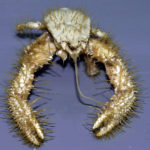- Series:Animals, Transcript English
Genesis 1:21
“And God created great whales, and every living creature that moveth, which the waters brought forth abundantly, after their kind, and every winged fowl after his kind: and God saw that it was good.”
 The Encyclopaedia Britannica has a startling article about yeti crabs – their habitat and their breeding patterns. Remarkably, these creatures live in hydrothermal vents in the south Pacific Ocean – in the vicinity of Easter Island. The pressure of sea water above the vents and the geothermal energy from below allows temperatures to reach 720°F (380°C). While this would be well hot enough to cook a crab in the kitchen, these strange creatures thrive in the conditions.
The Encyclopaedia Britannica has a startling article about yeti crabs – their habitat and their breeding patterns. Remarkably, these creatures live in hydrothermal vents in the south Pacific Ocean – in the vicinity of Easter Island. The pressure of sea water above the vents and the geothermal energy from below allows temperatures to reach 720°F (380°C). While this would be well hot enough to cook a crab in the kitchen, these strange creatures thrive in the conditions.
The yeti crab has unusually long claws for an animal of its size. These claws are covered with feathery hairs or setae, which, in turn, are covered with filamentous bacteria. Some scientists have suspected that these bacteria might, in fact, be the crab’s fuel source. These bacteria thrive in the high-sulfur content of the vents.
The animal is well adapted to living in these hostile conditions, but, strangely, the crab’s eggs cannot survive in the hydrothermal vents because of the high sulfur content. So female crabs have to leave their super-warm homes and swim to colder waters in order to lay their eggs. This change in climate is too great for most females to survive, and they tend to die after laying the eggs. After hatching, the larvae must make their way back into the super-heated conditions of the adults.
As always, we are startled and amazed by the diversity and complexity of God’s creation. Why did He make such unusual creatures? We do not yet know, but they
have some part to play in the strange ecosystem that is the hydrothermal vent. Author: Paul F. Taylor
We stand in awe again, Lord God, at the wonders of Your creation, wondering why and how You made such magnificent animals. Amen.
Ref: < https://www.mbari.org/discovery-of-yeti-crab/ >, accessed 5/1/2018. Image: license: CC BY-SA 2.0.
